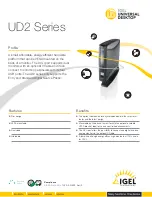
User Manual: 15E3 RevA
UM600172 Rev A, page 23 of 30
Care and Handling
The following tips will help keep your touchcomputer functioning at an optimal level:
•
Disconnect the AC power cable before cleaning.
•
To clean the unit (except touchscreen), use a clean cloth lightly dampened with a mild detergent.
•
It is important that your unit remains dry. Do not get liquids on or inside the unit. If liquid does get inside,
turn the unit off and have a qualified service technician check it before you power it on again.
•
Do not wipe the screen with a cloth or sponge that could scratch the surface.
•
To clean the touchscreen, use window or glass cleaner applied to a clean cloth or sponge. Never apply the cleaner directly to
the touchscreen. Do not use alcohol (methyl, ethyl or isopropyl), thinner, benzene, or other abrasive cleaners.
•
Ensure the environmental temperature and humidity are maintained within specification and do no block ventilation slots.
•
Touchcomputers are not designed for outdoors.
Waste Electrical & Electronic Equipment Directive (WEEE)
This product should not be disposed of with household waste. It should be deposited at a
facility that enables recovery and recycling. Ensure that product is disposed at the end of
its useful life according to local laws and regulations.
Elo has put in place recycling arrangements in certain parts of the world. For information
on how you can access these arrangements, please visit
https://www.elotouch.com/e-waste-recycling-program
UL Directive
The touchcomputer has a lithium battery included on the motherboard. There is a risk of
explosion if battery is replaced by an incorrect type. Please dispose of used batteries according
the region instructions.
Warning
It is important that your touchcomputer remains dry. Do not pour liquid into or onto your
touchcomputer. If your touchcomputer becomes wet, do not attempt to repair it yourself. Contact
Elo Customer Service for instructions.
This is a class A product. In a domestic environment this product may cause radio interference
in which case the user may be required to take adequate measures.







































